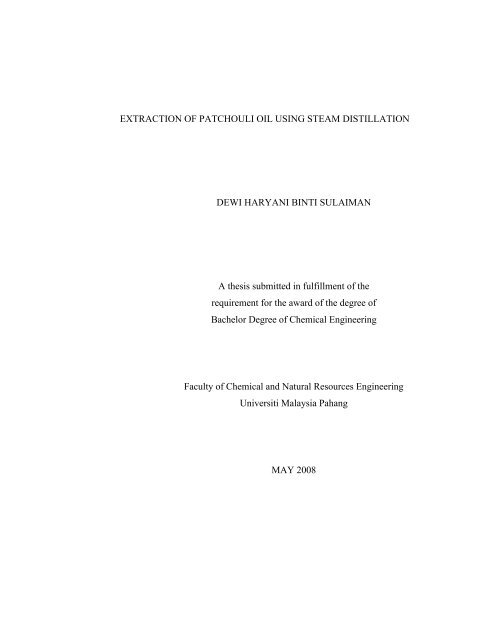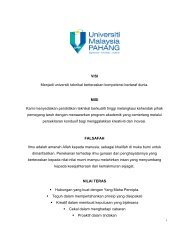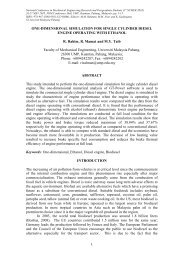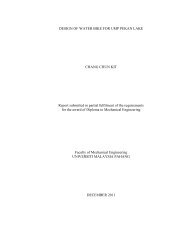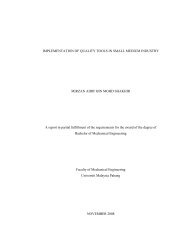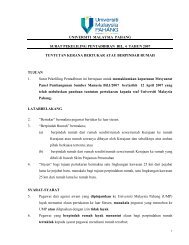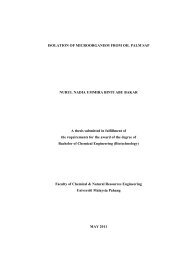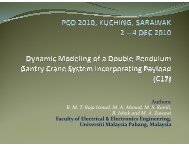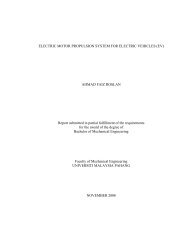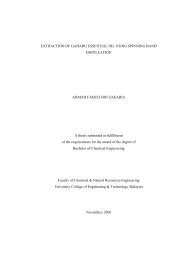draft: extraction of patchouli oil using steam distillation - Universiti ...
draft: extraction of patchouli oil using steam distillation - Universiti ...
draft: extraction of patchouli oil using steam distillation - Universiti ...
Create successful ePaper yourself
Turn your PDF publications into a flip-book with our unique Google optimized e-Paper software.
EXTRACTION OF PATCHOULI OIL USING STEAM DISTILLATION<br />
DEWI HARYANI BINTI SULAIMAN<br />
A thesis submitted in fulfillment <strong>of</strong> the<br />
requirement for the award <strong>of</strong> the degree <strong>of</strong><br />
Bachelor Degree <strong>of</strong> Chemical Engineering<br />
Faculty <strong>of</strong> Chemical and Natural Resources Engineering<br />
<strong>Universiti</strong> Malaysia Pahang<br />
MAY 2008
ii<br />
DECLARATION<br />
I declare that this thesis entitled “Extraction <strong>of</strong> Patchouli Oil Using Steam Distillation”<br />
is the result <strong>of</strong> my own research except as cited in the references. The thesis has not been<br />
accepted for any degree and is not concurrently submitted in candidature <strong>of</strong> any other<br />
degree.<br />
Signature : ………………………………..<br />
Name : Dewi Haryani binti Sulaiman<br />
Date : 14 May 2008
To my beloved parents, siblings, and fiancé<br />
iii
iv<br />
ACKNOWLEDGEMENT<br />
I wish to express my deepest gratitude to my supervisor, Miss. Suriyati binti Saleh<br />
for her tireless efforts and on-going support, advice as well as guidance, without whose<br />
help, my thesis would not have been completed successfully. I am also very thankful to<br />
my panels who have given useful suggestion and comments.<br />
I would like to extend my heartfelt gratitude to all my friends who <strong>of</strong>fer tips,<br />
advice and endless cooperation especially to postgraduate students who help to contribute<br />
ideas to my thesis.<br />
My appreciation to beloved parents, papa and mummy, for giving me support in<br />
all aspect like money and care to complete this thesis. Thank you to my siblings for their<br />
undivided courage support and also to my fiancé Syed Abdullah bin Syed Ahmad, who is<br />
always beside me for his moral support and love. I love you all.<br />
Last but not least, to others who have contributed direct or indirectly to the<br />
writing <strong>of</strong> this thesis. Your views and tips are very useful and priceless indeed. Thank<br />
you.
v<br />
ABSTRACT<br />
This study is about Extraction <strong>of</strong> Patchouli Oil Using Steam Distillation. The<br />
objective <strong>of</strong> this research is to study the feasibility <strong>of</strong> the optimum condition <strong>of</strong> <strong>steam</strong><br />
<strong>distillation</strong> in <strong>patchouli</strong> <strong>oil</strong> <strong>extraction</strong> process. Patchouli <strong>oil</strong> <strong>extraction</strong> is still new but has<br />
gained large market demand for the benefit on therapeutic and healing properties <strong>of</strong> this<br />
essential <strong>oil</strong>. However, cost-effective route have yet to be develop. This research has<br />
identified two scope <strong>of</strong> study to achieve the objective which is to vary the effect <strong>of</strong><br />
different <strong>extraction</strong> time and sample mass on the yields. In this <strong>extraction</strong>, part <strong>of</strong> the<br />
plant used is the leaves and stick. Firstly, the raw material is exposed 3 hours under direct<br />
sunlight and 3 days in room temperature. Dried <strong>patchouli</strong> plants are then cut to 2 cm in<br />
size. Then, the leaves are stacked in the <strong>extraction</strong> vessel. High pressured <strong>steam</strong> passed<br />
through the plant material from the bottom <strong>of</strong> the vessel. Hot <strong>steam</strong> will force open the<br />
pocket in which the essential <strong>oil</strong> <strong>of</strong> the <strong>patchouli</strong> was kept. Next, the <strong>steam</strong> which<br />
contains the essential <strong>oil</strong> passed through cooling system to condense the <strong>steam</strong> which<br />
would separate the essential <strong>oil</strong> from water. Pure <strong>oil</strong> is extracted with this method. For<br />
this equipment with the range <strong>of</strong> 7 hours <strong>extraction</strong> time and 2 kg to 4 kg sample masses,<br />
the optimum <strong>extraction</strong> time is at 7 hours with 3 kg sample mass.
vi<br />
ABSTRAK<br />
Projek ini bertajuk Pengekstrakan Minyak Nilam Menggunakan Penyulingan<br />
Berwap. Objektif projek ini ialah untuk mengetahui keadaan yang paling optimum untuk<br />
penyulingan berwap dalam melakukan proses pengekstrakan ini. Pengektrakan minyak<br />
nilam adalah masih baru di pasaran tetapi permintaan terhadap kebaikan minyak ini dari<br />
segi perubatan terapi telah mendapat sambutan meluas. Namun begitu, proses yang<br />
efektif dari segi kos masih lagi dalam kajian. Dalam projek ini, dua parameter telah<br />
ditetapkan untuk mencapai objektif projek ini iaitu kesan perubahan masa pengekstrakan<br />
dan berat nilam terhadap hasil penyulingan. Dalam proses ini bahagian yang digunakan<br />
ialah daun dan batang pokok nilam. Pertamanya, nilam perlu dikeringkan di bawah<br />
sinaran matahari selama 3 jam dan suhu bilik selama 3 hari. Nilam yang sudah<br />
dikeringkan itu di potong dalam anggaran saiz 2 cm. Kemudiannya, nilam itu akan<br />
dimasukkan ke dalam ‘vessel’ penyulingan dan wap air bertekanan tinggi akan di alirkan<br />
dari bawah ‘vessel’. Wap air yang panas ini akan menyebabkan minyak yang berada di<br />
dalam poket tumbuhan akan terbuka. Campuran wap air dan minyak nilam akan terus<br />
mengalir ke sistem penyejukan dan terkondensasi di mana air dan minyak nilam ini akan<br />
terpisah. Minyak yang asli kebayakannya mengunakan cara ini bagi proses pengeksrakan.<br />
Bagi alat ini untuk julat masa 7 jam masa pengekstrakan dan bagi berat jisim sampel di<br />
antara 2 kg hingga 4 kg, keadaan optimumnya ialah pada 7 jam masa pengekstrakan dan<br />
pada 3 kg berat sampel.
vii<br />
TABLE OF CONTENTS<br />
CHAPTER TITLE PAGE<br />
DECLARATION ii<br />
DEDICATION iii<br />
ACKNOWLEDGEMENT iv<br />
ABSTRACT v<br />
ABSTRAK vi<br />
TABLE OF CONTENT vii<br />
LIST OF SYMBOLS x<br />
LIST OF FIGURES xi<br />
LIST OF TABLES xiii<br />
LIST OF APPENDICES xiv<br />
1 INTRODUCTION<br />
1.1 Introduction 1<br />
1.2 Problem Statement 2<br />
1.3 Objective <strong>of</strong> the Study 3<br />
1.4 Scope <strong>of</strong> Study 3
viii<br />
2 LITERATURE REVIEW<br />
2.1 Essential Oil 4<br />
2.1.1 Benefit <strong>of</strong> Essential Oil 5<br />
2.1.2 Physical Properties 5<br />
2.1.3 Chemical Properties 6<br />
2.1.4 Types <strong>of</strong> Essential Oil 8<br />
2.1.5 Effect <strong>of</strong> Extraction Process to Essential Oil 9<br />
2.2 Patchouli 10<br />
2.2.1 Introduction 10<br />
2.2.2 Uses <strong>of</strong> Patchouli Oil 11<br />
2.2.3 Physical Properties <strong>of</strong> Patchouli Oil 12<br />
2.2.4 Chemical Components <strong>of</strong> Patchouli Extraction 12<br />
2.2.5 Chemical Structure in Patchouli Oil 15<br />
2.2.6 Patchouli Oil Industry 15<br />
2.3 Extraction <strong>of</strong> Essential Oil 16<br />
2.3.1 Hydro<strong>distillation</strong> 16<br />
2.3.2 Turbo Ultrasonic 17<br />
2.3.3 Superficial Fluid CO 2 17<br />
2.3.1 Steam Distillation Extraction 18<br />
2.4 Chromatography 19<br />
3 METHODOLOGY<br />
3.1 Introduction 20<br />
3.2 Pretreatment 21<br />
3.3 Extraction <strong>of</strong> Patchouli Oil 21<br />
3.3.1 Start-up Procedure 23<br />
3.3.2 Oil Yield Collection for Extraction Time 23<br />
Parameter<br />
3.3.3 Oil Yield Collection for Sample Mass Parameter 23<br />
3.4 Separation <strong>of</strong> Patchouli Oil and Water 24
ix<br />
3.5 Gas Chromatography Mass Spectrometer Analysis 24<br />
3.4 Overall Process <strong>of</strong> Patchouli Oil Extraction 26<br />
4 RESULT & DISCUSSION<br />
4.1 Introduction 27<br />
4.2 Observation 27<br />
4.2.1 Quantitative Study on Effect <strong>of</strong> Different 27<br />
Extraction Time on Oil Yield<br />
4.2.2 Quantitative Study on Effect <strong>of</strong> Different 28<br />
Sample Mass on Oil Yield<br />
4.2.2.1 Sample Mass at 2 kg Patchouli Plant 28<br />
4.2.2.2 Sample Mass at 4 kg Patchouli Plant 29<br />
4.3 Result/Data Collection 29<br />
4.3.1 Effect <strong>of</strong> Different Extraction Time on Oil 29<br />
Yield<br />
4.3.2 Effect <strong>of</strong> Different Sample Mass on Oil Yield 32<br />
4.4 Discussion 34<br />
4.4.1 Effect <strong>of</strong> Different Extraction Time on Oil 34<br />
Yield<br />
4.4.2 Effect <strong>of</strong> Different Sample Mass on Oil Yield 36<br />
4.4.3 Gas Chromatography Mass Spectrometer 38<br />
Analysis<br />
5 CONCLUSION & RECOMMENDATION<br />
5.1 Conclusion 40<br />
5.2 Recommendation 40<br />
List <strong>of</strong> References 42<br />
Appendices A-D 45
x<br />
LIST OF SYMBOLS<br />
USD $ - United State Dollar<br />
kg - Kilograms<br />
RT - Retention Time<br />
% - Percentage<br />
> - more than<br />
± - Estimation (plus minus)<br />
o C - Degree celcius<br />
T - Temperature<br />
cm - Centimeter<br />
atm - Atmospheric pressure
xi<br />
LIST OF FIGURES<br />
FIGURE NO. TITLE PAGE<br />
2.1 Bushy <strong>of</strong> Patchouli Leaves 10<br />
2.2 Patchouli Flower 11<br />
2.3 Patchouli leaves (cut) 11<br />
2.4 Fermented Patchouli Leave 11<br />
2.5 Structure <strong>of</strong> Major Constituents from P.cablin 15<br />
3.1 Process in Steam Distillation 20<br />
3.2 Schematic Diagram <strong>of</strong> Steam Distillation Equipment 22<br />
3.3 Steam Ditillation 22<br />
3.4 Rotary Evaporator 24<br />
3.5 Gas Chromatography Mass Spectrometer 25<br />
3.6 Process Flow Chart 26<br />
4.1 Oil Yield Proportional to Longer Extraction Time 28<br />
4.2 Volume <strong>of</strong> Oil Yield for the Effect <strong>of</strong> Different Extraction Time 34<br />
4.3 Average Volume <strong>of</strong> Oil Yield for the Effect <strong>of</strong> Different Extraction 35<br />
Time<br />
4.4 Mass <strong>of</strong> Oil Yield for the Effect <strong>of</strong> Different Extraction Time 35<br />
4.5 Average Mass <strong>of</strong> Oil Yield for the Effect <strong>of</strong> Different Extraction 35<br />
Time<br />
4.6 Oil Yield Percentage for the Effect <strong>of</strong> Different Extraction Time 36
xii<br />
4.7 Volume <strong>of</strong> Oil Yield for the Effect <strong>of</strong> Different Sample Mass 37<br />
4.8 Mass <strong>of</strong> Oil Yield for the Effect <strong>of</strong> Different Sample Mass 37<br />
4.9 Volume-Weight Percentage (v/w%) <strong>of</strong> Oil Yield for the Effect <strong>of</strong> 38<br />
Different Sample Mass<br />
4.10 Weight-Weight Percentage (w/w%) <strong>of</strong> Oil Yield for the Effect <strong>of</strong> 38<br />
Different Sample Mass<br />
4.11 Chromatogram <strong>of</strong> Patchouli Oil Analysis 39<br />
4.12 Mass Spectral Interpretation <strong>of</strong> Patchouli Oil Analysis 39
xiii<br />
LIST OF TABLES<br />
TABLE NO. TITLE PAGE<br />
1.1 Taxonomic Position <strong>of</strong> Patchouli 1<br />
2.1 Types <strong>of</strong> Essential Oil 8<br />
2.2 Chemical Compound Found in Patchouli Plant 13<br />
2.3 Main Compounds <strong>of</strong> the P.cablin Essential Oil 14<br />
4.1 Volume <strong>of</strong> Oil Yield for the Effect <strong>of</strong> Different Extraction Time 30<br />
4.2 Mass <strong>of</strong> Oil Yield for the Effect <strong>of</strong> Different Extraction Time 31<br />
4.3 Oil Yield Percentage for the Effect <strong>of</strong> Different Extraction Time 32<br />
4.4 Volume and Mass <strong>of</strong> Oil Yield for the Effect <strong>of</strong> Different Sample 33<br />
Mass<br />
4.5 Oil Yield Percentage for the Effect <strong>of</strong> Different Sample Mass 33
xiv<br />
LIST OF APPENDICES<br />
APPENDIX TITLE PAGE<br />
A Chromatography <strong>of</strong> Patchouli Oil First Sample (Sample 2) 45<br />
B Mass Spectral Interpretation <strong>of</strong> Patchouli Oil GC/MS 46<br />
C Chromatography <strong>of</strong> Patchouli Oil Second Sample (Sample 5) 51<br />
D Chromatogram <strong>of</strong> Patchouli Alcohol 52
CHAPTER 1<br />
INTRODUCTION<br />
1.1 Introduction<br />
Patchouli is an essential <strong>oil</strong> obtained from dried leaves or <strong>of</strong> a plant <strong>of</strong> the same<br />
name. Its botanical name is Pogostemon Cablin. Patchouli <strong>oil</strong> is widely used in perfumes<br />
as one <strong>of</strong> the important natural essential <strong>oil</strong>s used to give a base, lasting character and<br />
fixative ability to a fragrance. It is originated from East and West Indies and their name<br />
derives from the Tamil patchai (green), ellai (leaf). Patchouli is also known as<br />
patchouly, tamala pattra in Sanskrit and guang huo xiang in Chinese. Indonesia is the<br />
major producer <strong>of</strong> <strong>patchouli</strong> <strong>oil</strong> in the world with and estimated 550 tons per year, which<br />
is more than 80% <strong>of</strong> the total (Robbins, 1983; Tao, 1983). The taxonomic position <strong>of</strong><br />
<strong>patchouli</strong> is given below in Table 1.1 (Wikipedia, 2007. Patchouli).<br />
Table 1.1: Taxonomic position <strong>of</strong> <strong>patchouli</strong><br />
Kingdom<br />
Division<br />
Class<br />
Order<br />
Family<br />
Genus<br />
Species<br />
TAXONOMIC POSITION<br />
Plantae<br />
Magnoliophyta<br />
Magnoliopsida<br />
Lamiales<br />
Lamiaceae (Labiatae)<br />
Pogostemon<br />
P.cablin
2<br />
Before it became popular in Europe, the unique <strong>patchouli</strong> odor was being<br />
impregnate in the Indian shawls and Indian ink. Despite being used as alternative<br />
lifestyle in modern industry in fine products like cosmetic product as well as a<br />
component in about a third <strong>of</strong> modern, high-end perfumes, including more than half <strong>of</strong><br />
perfumes for men, <strong>patchouli</strong> is also an important ingredient in East Asian incense. It is<br />
also used in paper towels, laundry detergents, and air fresheners as a scent in products.<br />
Patchouli is a very fragrant, bushy herb with s<strong>of</strong>t oval leaves and square stems. It<br />
grows from two to three feet in height and provides an unusual odor that is nonetheless<br />
characteristic <strong>of</strong> <strong>patchouli</strong> when the leaves are rubbed. The plant grows well in southern<br />
climates. It enjoys hot weather but not direct sunlight. If the plant withers due to lack <strong>of</strong><br />
watering it will recover well and quickly once it has been watered. The seed-bearing<br />
flowers are very fragrant and bloom in late fall. The tiny seeds may be harvested for<br />
planting, but they are very delicate and easily crushed. Cuttings from the mother plant<br />
can also be rooted in water to produce further plants. Patchouli is a tropical member <strong>of</strong><br />
the mint family. Leaves are harvested several times a year, dried, and exported for<br />
<strong>distillation</strong> <strong>of</strong> the <strong>oil</strong>, although the highest quality <strong>oil</strong> is usually produce from fresh<br />
leaves, distilled close to the plantation (Wikipedia, 2007. Patchouli).<br />
An important component in a <strong>patchouli</strong> <strong>oil</strong>s is <strong>patchouli</strong> alcohol (C 15 H 26 O) or<br />
patchoulol known as terpene. Generally, <strong>patchouli</strong> <strong>oil</strong> consists <strong>of</strong> over 24 different<br />
sesquiterpen es. One <strong>of</strong> the organic compounds responsible for the typical <strong>patchouli</strong><br />
scent is the optical isomer. All the chemical compositions in the <strong>patchouli</strong> essential <strong>oil</strong><br />
are analyzed by <strong>using</strong> the Gas Chromatography Mass Spectrometry technology.<br />
1.2 Problem Statement<br />
At present, the essential <strong>oil</strong> industry is not only foc<strong>using</strong> to the production and<br />
distribution <strong>of</strong> essential <strong>oil</strong>s alone, but has focus more on the improvement <strong>of</strong> methods
3<br />
and maintenance <strong>of</strong> standard quality. This is because <strong>of</strong> the large market demand for the<br />
benefit in therapeutic and healing properties <strong>of</strong> the essential <strong>oil</strong>s. Patchouli <strong>oil</strong> is an<br />
important ingredient in many fine fragrance products but the <strong>patchouli</strong> <strong>oil</strong> <strong>extraction</strong> is<br />
still new compared to other essential <strong>oil</strong> <strong>extraction</strong>. However, cost-effective route to<br />
produce the <strong>oil</strong> has yet to be developed. Furthermore, the price <strong>of</strong> <strong>patchouli</strong> <strong>oil</strong><br />
increasing by years (Lerner and Ivan, 2003).This study focuses specifically on <strong>extraction</strong><br />
<strong>of</strong> <strong>patchouli</strong> <strong>oil</strong>, as it is widely appreciated for its pleasant characteristic and long lasting<br />
odor, and to find the best method for <strong>extraction</strong>. The <strong>extraction</strong> method used in this<br />
study is <strong>steam</strong> <strong>distillation</strong> as <strong>patchouli</strong> is commonly extracted <strong>using</strong> this method.<br />
1.3 Objective <strong>of</strong> the Study<br />
The objective <strong>of</strong> this research is to study the feasibility <strong>of</strong> the optimum condition<br />
<strong>of</strong> <strong>steam</strong> <strong>distillation</strong> in <strong>patchouli</strong> <strong>oil</strong> <strong>extraction</strong> process.<br />
1.4 Scope <strong>of</strong> Study<br />
In order to achieve the objective, the following scopes have been identified:<br />
1. Effect <strong>of</strong> different <strong>extraction</strong> time on <strong>oil</strong> yield<br />
2. Effect <strong>of</strong> different sample mass on <strong>oil</strong> yield.<br />
For the first parameter, <strong>extraction</strong> time, the sample mass is fixed for 6 hours<br />
duration where the <strong>oil</strong> yield will be record for every one hour starting from 3 hours. The<br />
same experiment will be run for three times to get the average reading for each<br />
<strong>extraction</strong> time. For the second parameter the yield will be recorded at different sample<br />
mass ranging from 2 kg to 4 kg and the yield will be record at certain period. The<br />
experiment also will be run for 7 hours.
CHAPTER 2<br />
LITERATURE REVIEW<br />
2.1 Essential Oil<br />
Early in history, the term “essential <strong>oil</strong>” or ”ethereal <strong>oil</strong>” defined as the volatile<br />
<strong>oil</strong> obtained by the <strong>steam</strong> <strong>distillation</strong> <strong>of</strong> plants. Essential <strong>oil</strong>s which are also referred to<br />
as “essences”, not only originated from flowers, but from herbs, shrubs, trees and<br />
various other plant materials.<br />
Gradually with the advance knowledge in science arise improvement in the<br />
methods <strong>of</strong> preparing the <strong>oil</strong>s, parallel with the development <strong>of</strong> a better knowledge<br />
understanding <strong>of</strong> the constituent <strong>of</strong> the <strong>oil</strong>s. It was found that the <strong>oil</strong> contains chiefly<br />
liquid and more or less volatile compound <strong>of</strong> many classes <strong>of</strong> organic substances usually<br />
dependent upon the oxygenated compounds. Four main groups, which are characteristic<br />
<strong>of</strong> the majority <strong>of</strong> the essential <strong>oil</strong>s, i.e.:<br />
1. Terpenes, related to isoprene or isopentene;<br />
2. Straight-chain compounds, not containing any side branches;<br />
3. Benzene derivatives;<br />
4. Miscellaneous<br />
(Haagen-Smit, 1949)<br />
Large volumes <strong>of</strong> <strong>oil</strong>s are usually distilled from leafy material such as<br />
lemongrass, citronella and cinnamon leaves. Meanwhile, the small volumes <strong>of</strong> <strong>oil</strong>s are
5<br />
usually distilled from fruits, seed, buds and flowers (e.g cloves, nutmeg and coriander).<br />
The percentages <strong>of</strong> characteristic differ at different part <strong>of</strong> the plant.<br />
2.1.1 Benefit <strong>of</strong> Essential Oil<br />
The plant derives specific benefit from its own essential <strong>oil</strong>s. The two major<br />
advantages they gain from their essential <strong>oil</strong> are as protection and reserve food. The<br />
irritating effect <strong>of</strong> many <strong>oil</strong>s affords a degree <strong>of</strong> protection against the depredations <strong>of</strong><br />
animals and plant parasites. In individual cases a contribution is made toward more<br />
effective pollination through insect visits. The action <strong>of</strong> some essential <strong>oil</strong>s is similar in<br />
certain respect to that <strong>of</strong> anaesthetics on animal cells. The inhibiting and damaging<br />
effect <strong>of</strong> the <strong>oil</strong>s on many life processes has been turned to our advantage in the use <strong>of</strong><br />
these compounds as bactericidal and fungicidal agents. In other cases <strong>of</strong> protection,<br />
plants which emanate a considerable amount <strong>of</strong> <strong>oil</strong>s are prevented from becoming too<br />
warm since heat is absorbed in the vaporization <strong>of</strong> the <strong>oil</strong>s. In this way the <strong>oil</strong> function<br />
as a water-sparing mechanism.<br />
As for human being, the essential <strong>oil</strong>s were regularly used in ancient Rome,<br />
Greece, and Egypt and throughout the Middle and Far East. Their common feature, the<br />
essence <strong>of</strong> a plant; an identifiable aroma, flavour, or other characteristic was <strong>of</strong> some<br />
practical use. They were used as perfumes, food flavours, deodorants, pharmaceuticals,<br />
and embalming antiseptics. For example, the essential <strong>oil</strong> is the primary ingredient in<br />
aromatherapy treatments which are safe and simple natural product.<br />
2.1.2 Physical Properties<br />
Most plants contain essential <strong>oil</strong>s but only the aromatic plants produce essential<br />
<strong>oil</strong> in sufficient quantities. They can be more or less fluid <strong>of</strong> which some are viscous;<br />
others are fairly solid and most are watery. They are sometimes resinous and <strong>of</strong>ten have
6<br />
a coloring, which ranges from yellow to emerald green and blue to dark brownish red.<br />
Essential <strong>oil</strong>s are diffuse and penetrating. Their high degree <strong>of</strong> vibratory capacity gives<br />
them this quality. Therefore, they should be kept in well stopper with a sound cork.<br />
Other than that, as essential <strong>oil</strong>s are very sensitive to heat and light, they should be<br />
stored in a cool place and dark bottles. In order to minimize oxygen exposure, a small<br />
amount <strong>of</strong> <strong>oil</strong> in a large bottle should be transferred to a small bottle instead. Another<br />
important physiochemical criterion <strong>of</strong> the quality and purity <strong>of</strong> an essential <strong>oil</strong> is the<br />
specific gravity which the values vary between the limits <strong>of</strong> 0.696 and 1.188 at 15°C<br />
which in general, the gravity is less than 1.000 (Gildemeister et al.,1956). Essential <strong>oil</strong> at<br />
15°C/15°C <strong>of</strong> specific gravity defined as the ratio <strong>of</strong> the weight <strong>of</strong> a given volume <strong>of</strong> <strong>oil</strong><br />
at 15°C to the weight <strong>of</strong> an equal volume water at 15°C. Essential <strong>oil</strong> b<strong>oil</strong> generally<br />
between 150 o C-300 o C (consist <strong>of</strong> many compound) however the compound are <strong>steam</strong><br />
volatile and can be distillate at around at 100 o C.<br />
2.1.3 Chemical Properties<br />
Essential <strong>oil</strong> chemical properties are usually analyze with a chromatography and<br />
the primary components are terpene hydrocarbons (monoterpene hydrocarbons and<br />
sesquiterpenes), oxygenated compounds consists <strong>of</strong> phenols and alcohols (monoterpene<br />
alcohols and sesquiterpene alcohols), aldehydes, ketones, esters, lactones, ethers and<br />
oxides.<br />
Most essential <strong>oil</strong>s consist <strong>of</strong> mixtures <strong>of</strong> hydrocarbons (terpenes, sesquiterpenes,<br />
etc.), oxygenated compounds (alcohols, esters, ethers, aldehydes, ketones, lactones,<br />
phenols, phenol ethers, etc.), and a small percentage <strong>of</strong> viscid or solid nonvolatile<br />
residuen (paraffin, waxes, etc.). Of these the oxygenated compound are the principal<br />
odor carriers, although the terpenes and sesquiterpenes, too, contribute in some degree to<br />
the total odor and flavor value <strong>of</strong> the <strong>oil</strong>. The oxygenated substances posses the added<br />
advantage <strong>of</strong> better solubility in dilute alcohol and, with the exception <strong>of</strong> some<br />
aldehydes, <strong>of</strong> greater stability against oxidizing and resinifying influences (Guenther,<br />
1949).
7<br />
Essential <strong>oil</strong>s that are rich in monoterpenoid constituent were those obtained<br />
from the leaves and fruit peels <strong>of</strong> C. hystrix, the fruit peel <strong>of</strong> C. aurantifolia, and the<br />
leaves <strong>of</strong> O. citriodorum. Limonene, α-pinene, β-pinene, linalool, geraniol, citral,<br />
terpinen-4-ol and alpha-terpineol were the major representatives <strong>of</strong> monoterpenoids<br />
present. Essential <strong>oil</strong>s that are rich with sesquiterpene constituent and phenyl propanoids<br />
were O. tenuiflorum and P.cablin (Nor Azah et al., 2007).<br />
The first primary component found is the terpenes hydrocarbons. One <strong>of</strong> it is the<br />
monoterpene compounds that are found in nearly all essential <strong>oil</strong>s and have a structure<br />
<strong>of</strong> 10 carbon atoms and at least one double bond. The other one is the sesquiterpenes<br />
consists <strong>of</strong> 15 carbon atoms and has complex pharmacological actions.<br />
Another primary component is the oxygenated compound consists <strong>of</strong> phenols<br />
and alcohols. Phenols found normally have a carbon side chain. Due to the nature <strong>of</strong><br />
phenols, essential <strong>oil</strong>s that are high in them should be used in low concentrations and for<br />
short periods <strong>of</strong> time, since they can lead to toxicity if used over long periods <strong>of</strong> time, as<br />
the liver will be required to work harder to excrete them. It can also cause skin and<br />
mucus membrane irritants and although they have great antiseptic qualities, like<br />
cinnamon and clove <strong>oil</strong>, they can cause severe skin reactions. Alcohols found in the<br />
essential <strong>oil</strong> like monoterpene alcohol on the other hand have good antiseptic, anti-viral<br />
and anti-fungal properties with very few side effects such as skin irritation or toxicity<br />
and have an uplifting energizing effect. As for sesquiterpene alcohols, they are not<br />
commonly found in essential <strong>oil</strong>s but when found they have great properties, which<br />
include liver and glandular stimulant, anti-allergen and anti-inflammatory. For the rest <strong>of</strong><br />
the other components, aldehydes, ketones, esters, ethers, and oxides are found in a small<br />
quantity.
8<br />
2.1.4 Types <strong>of</strong> Essential Oil<br />
Today, there is a lot <strong>of</strong> essential <strong>oil</strong> from different kind <strong>of</strong> aromatic plant. Table<br />
2.1 show some <strong>of</strong> the plants plant used in the <strong>extraction</strong> <strong>of</strong> essential <strong>oil</strong>s.<br />
Plant<br />
Part <strong>of</strong><br />
Plant<br />
Used<br />
Table 2.1: Types <strong>of</strong> essential <strong>oil</strong><br />
Botanical<br />
Name<br />
Chamomile Flower Matricaria<br />
recutita<br />
Cinnamon Leaf Cinnamomum<br />
zeylanicum<br />
Lavender Flower Lavendula<br />
intermedia<br />
Lemongrass Leaf Cymbopogon<br />
spp<br />
Sandalwood Wood Santalum<br />
Album<br />
Clove Bud Eugenia<br />
Caryophyllus<br />
Country<br />
<strong>of</strong><br />
Origin<br />
England,<br />
Germany,<br />
France,<br />
Morocco<br />
Sri Lanka,<br />
India<br />
England,<br />
France,<br />
Yugoslavia,<br />
Bulgaria<br />
Tanzania<br />
Nepal,<br />
Sri Lanka,<br />
Hawaii<br />
Turpentine Resin Pinus spp Mediterranean<br />
country<br />
Important<br />
Constituent<br />
Bisabolol<br />
Eugenol<br />
Linalol<br />
Citral,<br />
Citronella,<br />
Terpenes<br />
Santalol<br />
Properties<br />
Sedating,<br />
nurturing,<br />
soothing,<br />
calming,<br />
reassuring<br />
Condiment and<br />
flavouring<br />
material, antioxidant,<br />
antimicrobial<br />
Antidepressant,<br />
appeasing,<br />
balancing, ,<br />
purifying,<br />
relaxing,<br />
sedative,<br />
soothing<br />
Analgesic, antidepressant,<br />
antimicrobial.<br />
antipyretic,<br />
antiseptic,<br />
astringent,<br />
bactericidal<br />
Antimicrobial,<br />
antiseptics<br />
Indonesia Eugenol Carminative,<br />
anthelmintic,<br />
anodyne<br />
Terpenes<br />
Solvent for<br />
paints,<br />
antiseptic,<br />
Diuretic
9<br />
2.1.5 Effect <strong>of</strong> Extraction Process to Essential Oil<br />
A number <strong>of</strong> factors determine the final quality <strong>of</strong> a <strong>steam</strong> distilled essential <strong>oil</strong>.<br />
Aside from the plant material itself, most important are time, temperature and pressure,<br />
and the quality <strong>of</strong> the <strong>distillation</strong> equipment. Essential <strong>oil</strong>s are very complex products;<br />
each is made up <strong>of</strong> many, sometimes hundreds, <strong>of</strong> distinct molecules which come<br />
together to form the <strong>oil</strong>'s aroma and therapeutic properties. Some <strong>of</strong> these molecules are<br />
fairly delicate structures which can be altered or destroyed by adverse environmental<br />
conditions. So, much like a fine meal is more flavorful when made with patience, most<br />
<strong>oil</strong>s benefit from a long, slow 'cooking' process. The temperature <strong>of</strong> the <strong>extraction</strong><br />
chamber cannot be too high, lest some components <strong>of</strong> the <strong>oil</strong> be altered or destroyed.<br />
The same is true <strong>of</strong> the chamber's pressure. Lavender essential <strong>oil</strong>, for example,<br />
should not be processed at over 245 o F and pressure at 3 psi. Higher temperatures or<br />
pressures result in a 'harsh' aroma, more chemical than floral and lessen the <strong>oil</strong>'s<br />
therapeutic effects. Also, the <strong>extraction</strong> period must be allowed to continue for a certain<br />
period <strong>of</strong> time in order to flush all the <strong>oil</strong>'s components from the plant, as some are<br />
released more quickly than others.<br />
Despite the drawbacks <strong>of</strong> aggressive processing, high temperatures and pressures<br />
are <strong>of</strong>ten used to produces large quantities <strong>of</strong> <strong>oil</strong> in a short period <strong>of</strong> time. These <strong>oil</strong>s are<br />
usually destined for use in cosmetic and processed food manufacturing, but are<br />
sometimes sold to final consumers as essential <strong>oil</strong>s for use in aromatherapy. These <strong>oil</strong>s<br />
will be less expensive, but are <strong>of</strong> limited therapeutic value, and the difference is apparent<br />
when the aromas are compared side-by-side. ( The Ananda Apothecary, 2007. Making<br />
Essential Oil-Steam Distillation CO 2 and Absolutes)
10<br />
2.2 Patchouli<br />
2.2.1 Introduction<br />
Patchouli or scientifically known as Pogestoman cablin (P.cabin) is a member <strong>of</strong><br />
the mint family. Patchouli is perennial, bushy plant that grows up to three feet high, with<br />
a sturdy, hairy stem and large, fragrant, furry leaves, about four inches long and five<br />
inches across as shown in Figure 2.1 (Aroma-pure,2007.Patchouli). It has whitish<br />
flowers tinged with purple as shown in Figure 2.2 (Anniesremedy,2007.Herb). It grows<br />
in tropical climates. The plant originated from India and Indonesia. However become<br />
popular in the west beginning around 1844 when the first dried leaves, Figure 2.3<br />
(Scents-<strong>of</strong>-earth,2007.Patchouli), arrived in London. Before that, it was a well-known<br />
fragrance in Indian textiles throughout Europe. It is used as an insect repellant and<br />
perfume. It is a base note in several famous perfume ingredients for both men and<br />
women. It was grown in China almost two thousand year ago and was used as a perfume<br />
for ink. Today, it is commonly used in cigarettes to compensate for a lack <strong>of</strong> taste due to<br />
reduced tar content. Good quality <strong>patchouli</strong> will retain its sweeter notes on a perfume<br />
blotter for months. The leaves must be fermented, Figure 2.4 (Alchemyworks,2007.Herb),<br />
during the process before they could produce the full blast <strong>of</strong> their<br />
scent.<br />
Figure 2.1: Bushy <strong>of</strong> <strong>patchouli</strong> leaves


